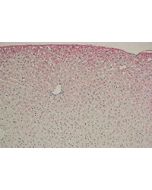Cookie Policy: This site uses cookies to improve your experience. You can find out more about our use of cookies in our Privacy Policy. By continuing to browse this site you agree to our use of cookies.
JaICA
anti-Dityrosine [DT], mAb (1C3)

| Product Details | |
|---|---|
| Product Type | Monoclonal Antibody |
| Properties | |
| Clone | 1C3 |
| Isotype | Mouse IgG2aκ |
| Immunogen/Antigen | 3-(p-hydroxyphenyl) propionic acid dimer-conjugated keyhole limpet hemocyanin. |
| Application |
ELISA |
| Crossreactivity |
All Human |
| Specificity |
Recognizes free dityrosine, 3-(p-hydroxyphenyl) propionic acid dimer, dityrosine-BSA conjugate, and dityrosine in protein or peptides. Does not cross-react with nitrotyrosine, chlorotyrosine, aminotyrosine, phosphotyrosine, tyrosine, 3-(p-hydroxyphenyl) propionic acid, phenylalanine, 3,4-dihydroxyphenylacetic acid (DOPA). |
| Purity Detail | Protein A purified. |
| Formulation | Lyophilized. Contains 10mM PBS (pH7.4). |
| Reconstitution | Reconstitute with 200μL distilled water. |
| Isotype Negative Control | |
| Other Product Data |
Click here for Original Manufacturer Product Datasheet |
| Declaration | Manufactured by JaICA. |
| Shipping and Handling | |
| Shipping | BLUE ICE |
| Short Term Storage | +4°C |
| Long Term Storage | -20°C |
| Handling Advice | Avoid freeze/thaw cycles. |
| Use/Stability | Stable for at least 3 years after receipt when stored at -20°C. |
| Documents | |
| Product Specification Sheet | |
| Datasheet |
 Download PDF Download PDF |
Tyrosine is one of the major targets of protein oxidation. Dityrosine (DT) is known to be formed when tyrosine is damaged by free radicals, such as reactive oxygen species (ROS), metal-catalyzed oxidation, ultraviolet irradiation, and peroxidases. Dityrosine has been found in atherosclerotic lesions, and lipofuscin of pyramidal neurons of aged human brains. Dityrosine is a specific biomarker for protein oxidation. Dityrosine is reported to exist in various tissues and was also recently detected in urine samples. It is expected to be a novel protein oxdation marker, which is non-invasively detectable.
- Immunochemical detection of protein dityrosine in atherosclerotic lesion of apo-E-deficient mice using a novel monoclonal antibody: Y. Kato, et al.; BBRC 275, 11 (2000)
- The hydrogen peroxide/copper ion system, but not other metal-catalyzed oxidation systems, produces protein-bound dityrosine: Y. Kato, et al.; Free Radic. Biol. Med. 31, 624 (2001)
- Copper mediates dityrosine cross-linking of Alzheimer’s amyloid-beta: C.S. Atwood, et al.; Biochemistry 43, 560 (2004)
- Immunohistochemical detection of oxidative stress biomarkers, dityrosine and N(epsilon)-(hexanoyl)lysine, and C-reactive protein in rabbit atherosclerotic lesions: Y. Fukuchi, et al.; J. Atheroscler. Thromb. 15, 185 (2008)
- Expressions of protein oxidation markers, dityrosine and advanced oxidation protein products in Cisplatin-induced nephrotoxicity in rats: Y. Kimoto, et al.; J. Vet. Med. Sci. 73, 403 (2011)
- Effect of protein malnutrition on the skin epidermis of hairless mice: A. Sugiyama, et al.; J. Vet. Med. Sci. 73, 831 (2011)
- Expressions of protein oxidation markers, dityrosine and advanced oxidation protein products in acetaminophen-induced liver injury in rats: J. Sun, et al.; J. Vet. Med. Sci. 73, 1185 (2011)
- Intramolecular cross-linking in the native JHBP molecule: D. Bystranowska, et al.; Arch. Biochem. Biophys. 517, 12 (2012)
- Di-tyrosine cross-link decreases the collisional cross-section of Ab peptide dimers and trimers in the gas phase: An ion mobility study: E. Sitkiewicz, et al.; PLOS One 9, e100200 (2014)







![anti-4-Hydroxy-2-hexenal [4-HHE], mAb (HHE53)](https://update.adipogen.com/media/catalog/product/placeholder/default/adipogen_logo_bw_3.png)
